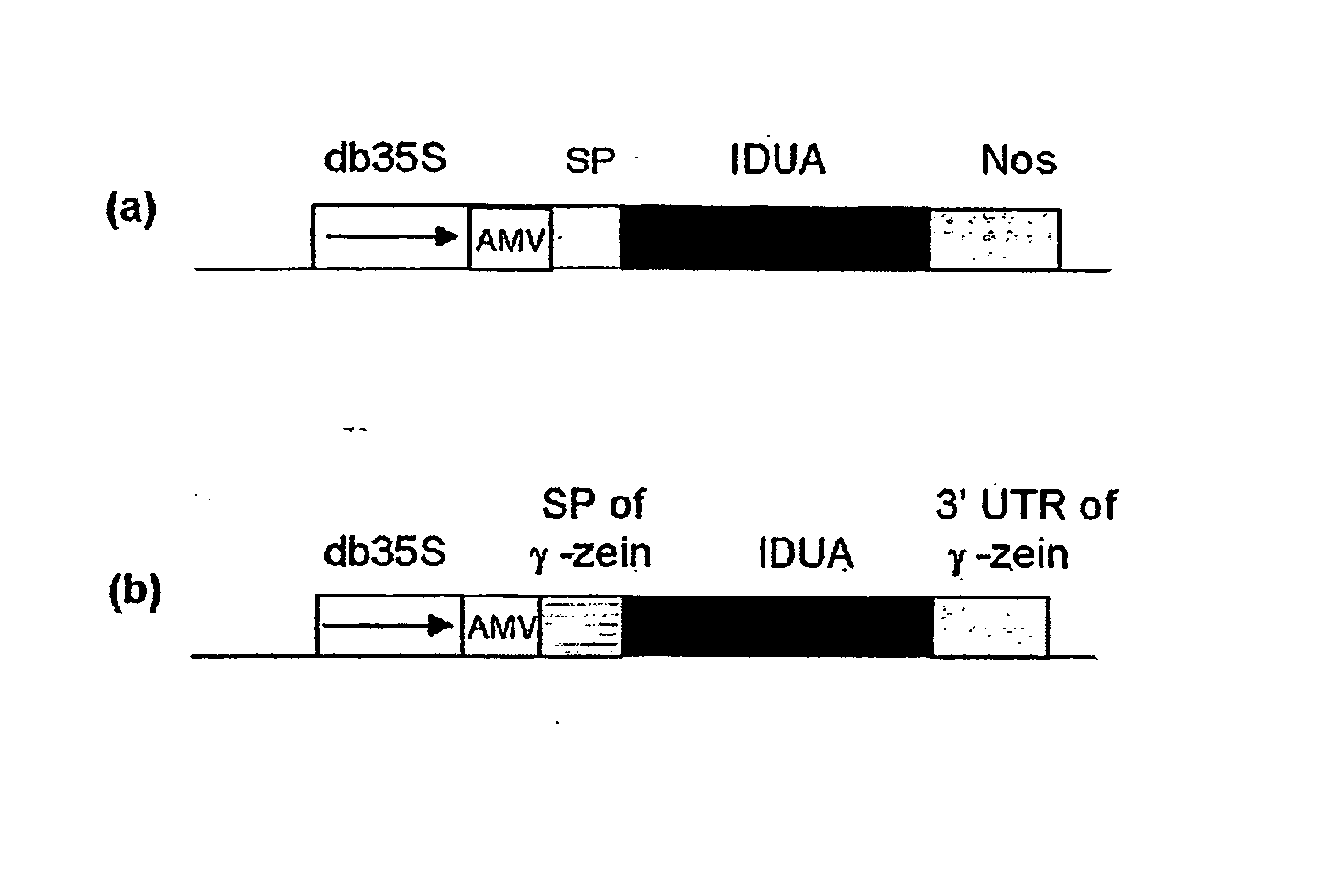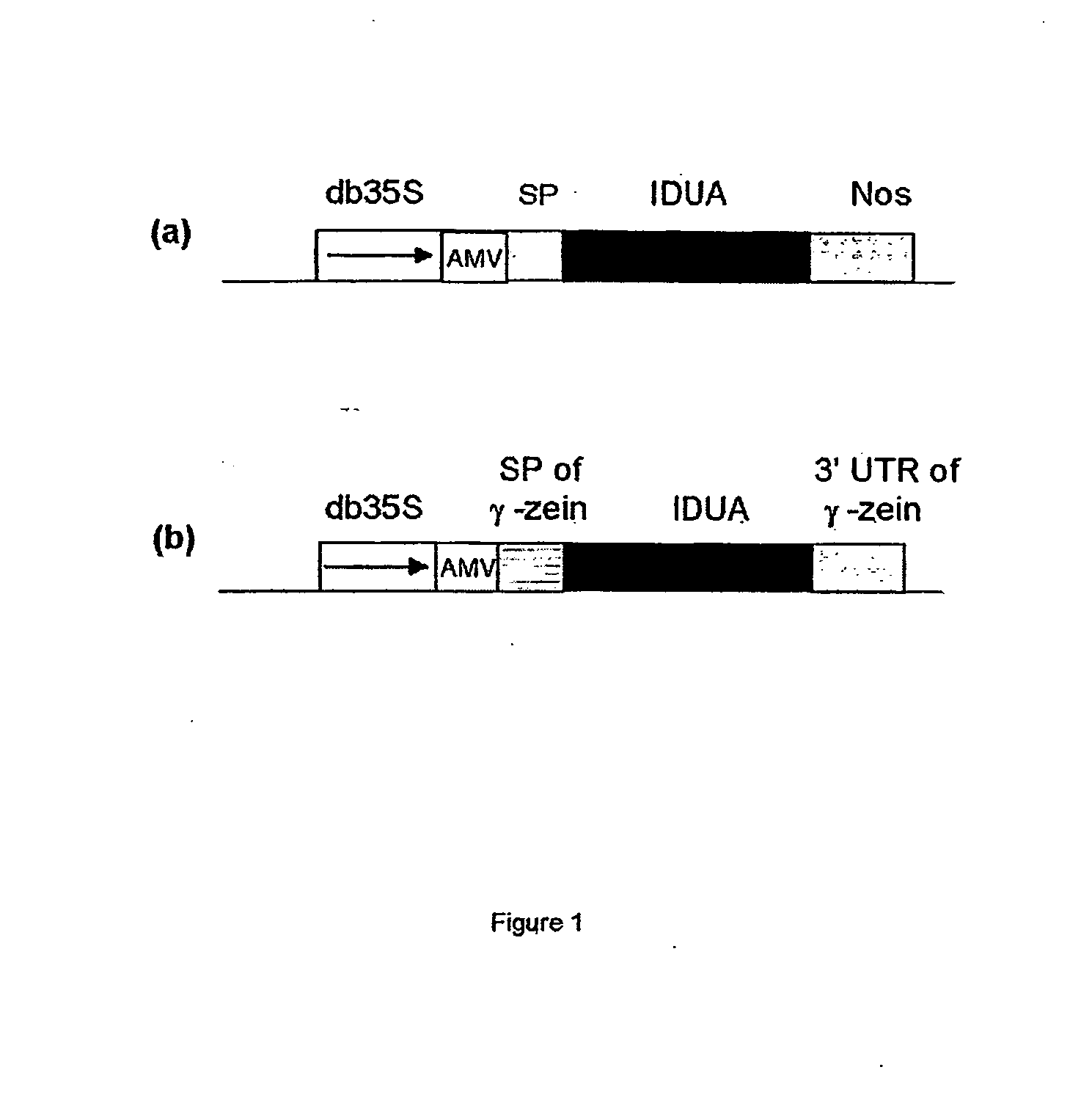Production Of A Protein Localized To The Endoplasmic Reticulum Protein Bodies In A Transgenic Plant And Seed
a technology of endoplasmic reticulum and protein body, which is applied in the field of plant protein production, can solve the problems of affecting the inability to produce transient enzymes in plant cells, and the high cost of current methods used to produce these enzymes (most commonly human fibroblasts or chinese hampster ovary cells). achieve the effect of facilitating the localization of prolamin
- Summary
- Abstract
- Description
- Claims
- Application Information
AI Technical Summary
Benefits of technology
Problems solved by technology
Method used
Image
Examples
example 1
Expression of Human IDUA in Maize Calli
[0116] To investigate whether maize expressed human IDUA is enzymatically active, the following constructs were prepared using standard techniques (e.g. Maniatis et al., in Molecular Cloning (A Laboratory Manual), Cold Spring Harbor Laboratory, 1982, which is incorporated herein by reference): [0117] double (enhanced) 35S promoter-AMV-IUDA-nos (FIG. 1a)—comprising the enhanced 35S promoter (Fang et al., Plant Cell 1, 141-150, 1989), multiple cis regulatory elements for maximal expression of the cauliflower mosaic virus 35 S promoter in transgenic plants, an AMV (alfalfa mosaic virus) leader sequence (Dalta et al., Plant Sci. 94, 139-149, 1993) the IDUA coding region (Scott, H. S., et. al., Proc Natl Acad Sci USA 88, 9695-9699; 1991; GenBank accession no. M74715), and a 3′ end derived from the Nos (Depicker et al., J Mol Appl Genet. 1, 561-573, 1982). [0118] double 35S promoter-AMV-γ-zein SP-IUDA-γ-zein 3′UTR (FIG. 1b)—the enhanced 35S promoter...
example 2
Expression of IDUA in Transgenic Maize Seeds
[0126] To investigate the potential of targeting the recombinant IDUA to protein bodies of maize, the human α-L-iduronidase (IDUA) gene (Scott, H. S., et. al., Proc Natl Acad Sci USA 88, 9695-9699; 1991; GenBank accession no. M74715) was driven by the 1.7-kb γ-zein promoter (obtained from the γ-zein gene; Reina, M., et. al., Nucl. Acids Res. 18, 6426; 1990; GenBank accession no. X53514). Additional regulatory sequences flanking the IDUA mature coding region included the γ-zein 5′ UTR (9 bp), the γ-zein signal peptide (57 bp) and the γ-zein 3′ UTR (191 bp) (FIG. 3b). A control construct contained the γ-zein promoter, the 5′UTR- and signal-peptide-encoding sequences of the human IDUA gene and a Nos (nopaline synthase gene) 3′ region (UTR and transcription termination sequences; FIG. 3a).
[0127] To clone the 5′ UTR, signal peptide-encoding sequences and 3′ UTR of the γ-zein gene, genomic DNA was extracted from maize Hi-II. For cloning of the...
PUM
 Login to View More
Login to View More Abstract
Description
Claims
Application Information
 Login to View More
Login to View More - R&D
- Intellectual Property
- Life Sciences
- Materials
- Tech Scout
- Unparalleled Data Quality
- Higher Quality Content
- 60% Fewer Hallucinations
Browse by: Latest US Patents, China's latest patents, Technical Efficacy Thesaurus, Application Domain, Technology Topic, Popular Technical Reports.
© 2025 PatSnap. All rights reserved.Legal|Privacy policy|Modern Slavery Act Transparency Statement|Sitemap|About US| Contact US: help@patsnap.com



